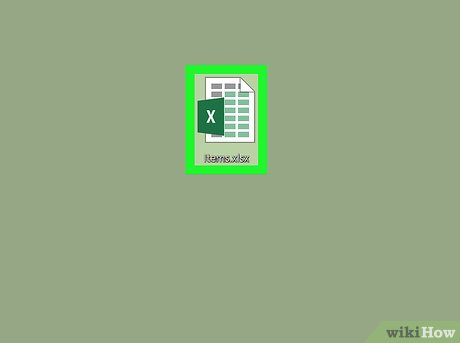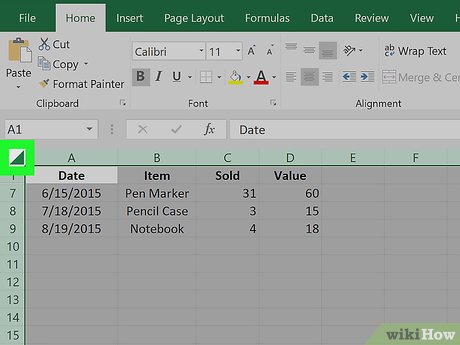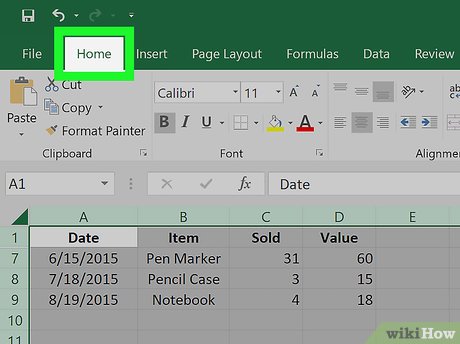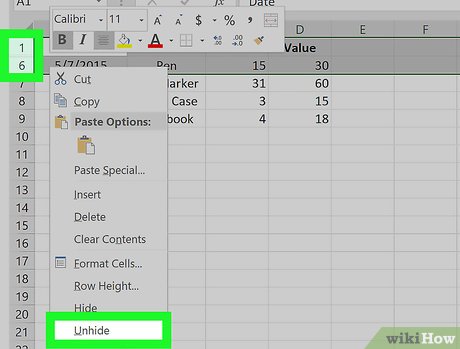How to Unhide Rows in Excel
Method 1 of 3:
Unhiding All Hidden Rows
-
 Open the Excel document. Double-click the Excel document that you want to use to open it in Excel.
Open the Excel document. Double-click the Excel document that you want to use to open it in Excel. -
 Click the "Select All" button. This triangular button is in the upper-left corner of the spreadsheet, just above the 1 row and just left of the A column heading. Doing so selects your entire Excel document.
Click the "Select All" button. This triangular button is in the upper-left corner of the spreadsheet, just above the 1 row and just left of the A column heading. Doing so selects your entire Excel document.- You can also click any cell in the document and then press Ctrl+A (Windows) or ⌘ Command+A (Mac) to select the whole document.
-
 Click the Home tab. This tab is just below the green ribbon at the top of the Excel window.
Click the Home tab. This tab is just below the green ribbon at the top of the Excel window.- If you're already on the Home tab, skip this step.
-
 Click Format. This option is in the "Cells" section of the toolbar near the top-right of the Excel window. A drop-down menu will appear.
Click Format. This option is in the "Cells" section of the toolbar near the top-right of the Excel window. A drop-down menu will appear. -
 Select Hide & Unhide. You'll find this option in the Format drop-down menu. Selecting it prompts a pop-out menu to appear.
Select Hide & Unhide. You'll find this option in the Format drop-down menu. Selecting it prompts a pop-out menu to appear. -
 Click Unhide Rows. It's in the pop-out menu. Doing so immediately causes any hidden rows to appear in the spreadsheet.
Click Unhide Rows. It's in the pop-out menu. Doing so immediately causes any hidden rows to appear in the spreadsheet.- You can save your changes by pressing Ctrl+S (Windows) or ⌘ Command+S (Mac).
Method 2 of 3:
Unhiding a Specific Row
-
 Open the Excel document. Double-click the Excel document that you want to use to open it in Excel.
Open the Excel document. Double-click the Excel document that you want to use to open it in Excel. -
 Find the hidden row. Look at the row numbers on the left side of the document as you scroll down; if you see a skip in numbers (e.g., row 23 is directly above row 25), the row in between the numbers is hidden (in 23 and 25 example, row 24 would be hidden). You should also see a double line between the two row numbers.[1]
Find the hidden row. Look at the row numbers on the left side of the document as you scroll down; if you see a skip in numbers (e.g., row 23 is directly above row 25), the row in between the numbers is hidden (in 23 and 25 example, row 24 would be hidden). You should also see a double line between the two row numbers.[1] -
 Right-click the space between the two row numbers. Doing so prompts a drop-down menu to appear.
Right-click the space between the two row numbers. Doing so prompts a drop-down menu to appear.- For example, if row 24 is hidden, you would right-click the space between 23 and 25.
- On a Mac, you can hold down Control while clicking this space to prompt the drop-down menu.
-
 Click Unhide. It's in the drop-down menu. Doing so will prompt the hidden row to appear.
Click Unhide. It's in the drop-down menu. Doing so will prompt the hidden row to appear.- You can save your changes by pressing Ctrl+S (Windows) or ⌘ Command+S (Mac).
-
 Unhide a range of rows. If you notice that several rows are missing, you can unhide all of the rows by doing the following:
Unhide a range of rows. If you notice that several rows are missing, you can unhide all of the rows by doing the following:- Hold down Ctrl (Windows) or ⌘ Command (Mac) while clicking the row number above the hidden rows and the row number below the hidden rows.
- Right-click one of the selected row numbers.
- Click Unhide in the drop-down menu.
Method 3 of 3:
Adjusting Row Height
-
 Understand when this method is necessary. One form of hiding rows involves the height of the row(s) in question to be so short that the row effectively disappears. You can reset the height of all spreadsheet rows to "14.4" (the default height) to address this.
Understand when this method is necessary. One form of hiding rows involves the height of the row(s) in question to be so short that the row effectively disappears. You can reset the height of all spreadsheet rows to "14.4" (the default height) to address this. -
 Open the Excel document. Double-click the Excel document that you want to use to open it in Excel.
Open the Excel document. Double-click the Excel document that you want to use to open it in Excel. -
 Click the "Select All" button. This triangular button is in the upper-left corner of the spreadsheet, just above the 1 row and just left of the A column heading. Doing so selects your entire Excel document.
Click the "Select All" button. This triangular button is in the upper-left corner of the spreadsheet, just above the 1 row and just left of the A column heading. Doing so selects your entire Excel document.- You can also click any cell in the document and then press Ctrl+A (Windows) or ⌘ Command+A (Mac) to select the whole document.
-
 Click the Home tab. This tab is just below the green ribbon at the top of the Excel window.
Click the Home tab. This tab is just below the green ribbon at the top of the Excel window.- If you're already on the Home tab, skip this step.
-
 Click Format. This option is in the "Cells" section of the toolbar near the top-right of the Excel window. A drop-down menu will appear.
Click Format. This option is in the "Cells" section of the toolbar near the top-right of the Excel window. A drop-down menu will appear. -
 Click Row Height…. It's in the drop-down menu. This will open a pop-up window with a blank text field in it.
Click Row Height…. It's in the drop-down menu. This will open a pop-up window with a blank text field in it. -
 Enter the default row height. Type 14.4 into the pop-up window's text field.
Enter the default row height. Type 14.4 into the pop-up window's text field. -
 Click OK. Doing so will apply your changes to all rows in the spreadsheet, thus unhiding any rows which were "hidden" via their height properties.
Click OK. Doing so will apply your changes to all rows in the spreadsheet, thus unhiding any rows which were "hidden" via their height properties.- You can save your changes by pressing Ctrl+S (Windows) or ⌘ Command+S (Mac).
4 ★ | 3 Vote



















 How to Change from Lowercase to Uppercase in Excel
How to Change from Lowercase to Uppercase in Excel How to Create a Custom Macro Button in Excel
How to Create a Custom Macro Button in Excel How to Freeze Cells in Excel
How to Freeze Cells in Excel How to Round in Excel
How to Round in Excel How to Create a Timeline in Excel
How to Create a Timeline in Excel How to Create Pivot Tables in Excel
How to Create Pivot Tables in Excel